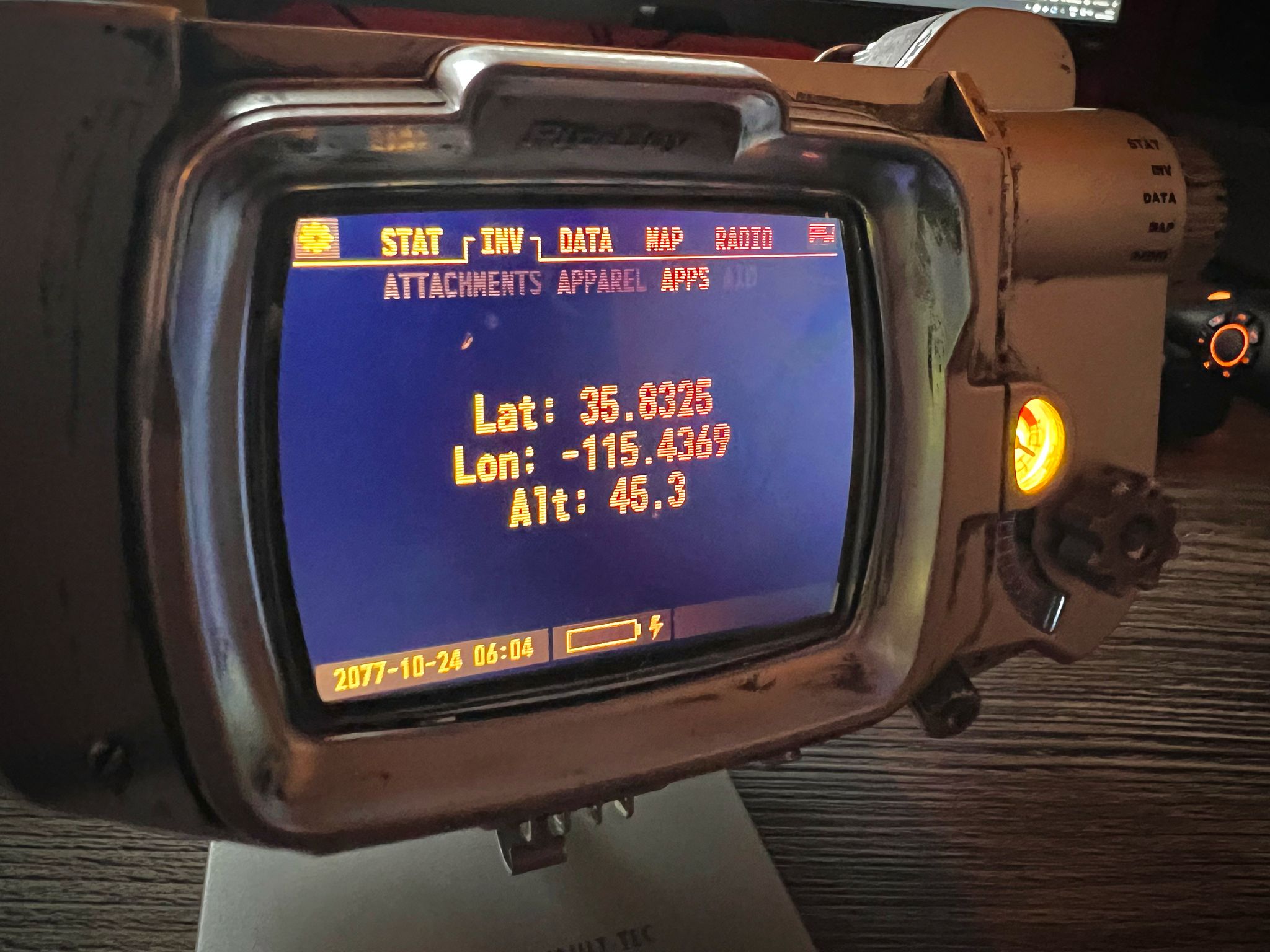Following on from previous articles where I had worked out UART connectivity to the Pip-Boy 3000 Mk.V, and then more recently working out how to run custom code at boot time, I decided to do a quick proof of concept tying some of these things together to demonstrate the art of the possible.
Looking around the collection of electronics on my desk I noticed that I had a PA1010D GPS board (which is actually destined for my Pip-Boy 2000 Mk.VI, also by The Wand Company). I still also have the UART wires hanging out the back of my 3000 Mk.V from previous experiments so hey why not throw it on there and see what happens.

It’s not pretty, but for the purpose of this experiment, that’s okay. The board I have is actually designed for I2C but there are UART pads on the other side of the board too so I soldered onto those.
The chip powers up, now to see if we get any data. As described in a previous log (Adding connectivity to the Pip-Boy 3000 Mk V) the UART connection here is available on Serial3 in Espruino, so we should setup that port using the methods described in https://www.espruino.com/Reference#Serial.
One thing that I learned at this stage, is that devices that send a lot of data over UART can quite quickly swamp the RAM of the Pip-Boy and will crash it. To avoid this I found it best to add the event handlers to the port before setting the port connection up.
// Create a buffer string to store incoming data
let buf = "";
// Remove any existing event handlers on the serial port
Serial3.removeAllListeners();
// Create a new event handler for data events
Serial3.on("data", function (d) {
buf += d.toString(); // Add the data to the buffer
let e;
// When a newline is encountered, get the whole line
// and then reset the buffer
while ((e = buf.indexOf("\n")) >= 0) {
const m = buf.substring(0, e).trim();
buf = buf.substring(e + 1);
console.log(m); // Log the message line
}
});
// Setup the port on 9600 baud, this is the baud of the
// GPS chip, it's different to the baud used by the console
Serial3.setup(9600);
The console is now spammed with NMEA messages from the PA1010D and to test these looked about as expected, I copy pasted them all into https://swairlearn.bluecover.pt/nmea_analyser.
Parsing NMEA sentences
I started out by writing functions to parse the NMEA data and then after sleeping on it, I realised that there’s already an Espruino module for Serial GPS devices, which saves a whole pile of headache.
To read more about loading external modules, I’ve added a section to the documentation about it: Modules.
// Add the external GPS module to the cache
Modules.addCached("GPS", require("fs").readFileSync("MODULES/GPS.min.js"));
// Setup the serial connection
Serial3.setup(9600);
// Connect the GPS module to the Serial port
var gps = require("GPS").connect(Serial3, function (d) {
// If there's a GPS fix, draw the lat/lon to the screen
if (d.fix) {
bC.clear()
.setFontMonofonto28()
.setColor(1, 1, 1)
.setFontAlign(0, 0)
.drawString(
`Lat: ${Math.round(d.lat * 10000) / 10000}\nLon: ${
Math.round(d.lon * 10000) / 10000
}\nAlt: ${d.altitude}`,
200,
105
)
.flip();
} else {
// There's not enough satellites in view
bC.clear()
.setFontMonofonto28()
.setColor(1, 1, 1)
.drawString("No fix")
.flip();
}
});
That’s it! The screen now shows my position. The GPS module also parses the time from the NMEA data so I could also use this step to precisely set the time on the device too if I wanted.
Where’s the maps?
Yeah, I know.
The tricky thing with adding maps is that there is no live data connection to the Pip-Boy, so I think the probable best way to tackle this is to cache map tiles for an area you will be in onto the SD card and then draw tiles to screen and use that for positioning.
Espruino have actually published an OpenStreetMap app for their Bangle smartwatch https://github.com/espruino/BangleApps/tree/master/apps/openstmap and with some work it could be possible to adapt this to the Pip-Boy too, so it’s definitely not impossible, but I currently do not have the time. If someone wants to take on that project though, I will happily advise and/or contribute.
